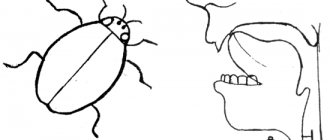Classifications
Different researchers understand emotional processes differently and classify them differently. There are theories (for example, S. Schechter’s two-factor theory of emotions) that even suggest the existence of only one
emotions, which, depending on various factors, can cause certain experiences. According to such theories, there is nothing to classify.
Many Western researchers, studying emotional processes, pay attention to them as a whole, focusing on general patterns and the nature of the phenomenon. Such researchers usually use the concept “emotion” to refer to any emotional processes, and the task of classification is beyond the scope of their work
For example, K. E. Izard assumes that there is a set of 10 basic emotions, and considers all other emotional processes as their combination and modifications. Accordingly, he pays main attention to basic emotions, and not to the classification of derivatives.
Affects, emotions, feelings, moods
In Russian psychology, the practice of classifying emotional processes into affects, emotions and feelings, depending on their psychological characteristics and patterns of occurrence, has become widespread. Often moods are also distinguished as a separate class. The result is the following classification:
- Affects are short-term and intense emotional processes, accompanied by pronounced motor manifestations and changes in the functioning of internal organs. For example, fear.
- Emotions are longer-lasting and less intense than affects, emotional processes that reflect the subjective meaning of situations, but not specific objects in themselves. For example, anxiety.
- Feelings are longer lasting and less intense than affects, emotional processes that reflect the subjective meaning of specific objects. For example, hatred.
- Moods are fairly long-lasting emotional processes of low intensity. For example, boredom.
Basic emotions
Many researchers are trying, for various reasons, to identify the so-called basic
or
fundamental emotions
- that is, those elementary emotional processes that make up the entire diversity of a person’s emotional life. Various researchers offer different lists of these emotions, but a single and generally accepted one does not yet exist.
examines 18 basic and 4 complex emotions.
C. E. Izard offers the following list of basic emotions:
- interest - excitement;
- pleasure - joy;
- astonishment;
- grief - suffering;
- anger - rage;
- disgust - disgust;
- contempt - disdain;
- fear - horror;
- shame - shyness;
- guilt - repentance.
Dodonov classification
Soviet psychologist B.I. Dodonov proposed a classification of emotional processes based on, in his opinion, human needs associated with these emotional processes:
- altruistic;
- communicative;
- gloric;
- practical;
- fearful;
- romantic;
- Gnostic;
- aesthetic;
- hedonistic;
- active emotions.
Each person, Dodonov notes, has his own “emotional melody” - a general emotional orientation, characterized by the emotions that are closest to the person, desirable and constant.
Basic emotions and their characteristics article on correctional pedagogy on the topic
| Basic emotions and their characteristics; “a workaround for the development of a child with disabilities” |
In this question, we will consider 10 basic emotions and variants (scales) of manifestations of each of them; We will briefly describe each emotion so that the teacher can clearly understand what is hidden behind each concept. Then you can more clearly imagine what and how to educate a child.
Each of these emotions performs several functions:
- biological - directs blood and energy resources;
- motivating influence - directs and encourages perception, thinking, behavior;
social function - ensures and organizes the child’s interaction with people.
It is important to remember that emotions are immutable; only the form of their manifestation changes. Joy is always joy; sadness is sadness, but the form of manifestation in childhood, adolescence, maturity is different.
Differential Emotions Scale[1]
| 1. Interest is a basic emotion that manifests itself in the processes: |
|
| 2. Joy - |
|
| 3. Surprise - |
|
| 4. Sadness - |
|
| 5. Anger - |
|
| 6. Disgust - |
|
| 7. Contempt - |
|
| 8. Fear - |
|
| 9. Shame - |
|
| 10. Wine - |
|
When studying the characteristics of a child’s experience when experiencing basic emotions, scientists (Bartlett, Izard, Knowlis, etc.) proceeded from this. That emotional experience is a multifaceted phenomenon that reflects different aspects of a person’s feelings, thinking and behavior. Each of the 10 basic emotions is represented by three effective states through which they manifest themselves.
The most important emotion in a person is interest, because... It is this emotion that ensures the performance of a child, a person.
So, sometimes during a lesson a child switches off, fidgets, disturbs others - that means he is not interested. And the teacher is straining himself, using various kinds of administrative instructions: now, I’ll punish you; if you interfere, you won’t go for a walk with us; You turn around and turn around with me - then you’ll get it, etc.
All you have to do is come up and say: “You probably came up with something new, unusual, but you don’t know how to do it. Tell me in my ear what you're thinking, I'll try to help you if I can...(or something like that).
With this type of communication, an attempt is made to intensify the child’s interest in his actions; and if this works out, then there will be actions by the child in modeling, drawing, storytelling, etc.
And if not? Then the teacher must use any tricks, special ones. effects to achieve this. Well, for example, children don’t want to, they can’t, clap the rhythm, repeat the movements, remember the sequence of operations - attach bright pieces of fabric, toys, light bulbs to their legs and arms, body and let the children repeat the rhythm of the movement, sequence of actions, etc.
Change, animation, novelty - this is not a complete list of reasons that arouse interest. Remember this and use in your work not the same visual aids, but a variety of diagrams, tables, etc.
Come to work in different clothes, different makeup; change your slippers (or their parts, pompoms, attach pieces of multi-colored fabrics, etc.) in kindergarten and draw the kids’ attention to this.
“What color are my slippers today? What has changed in them? Why? Try to determine my mood, and if you can, correct it.”
Approximate symbolism of flowers: blue slippers - sadness; red slippers - joy; green slippers are a pleasure...
And another fact! The brain of a newborn child has almost 90% of the nerve cells of the adult brain, but it is not a fully developed substrate. Considering that the formation of interanalyzer connections is due to the influence of the environment, and the emotion of interest is the motivating force of the child’s constant sensory interaction with the environment, the conclusion suggests itself that the emotion of interest contributes to brain development.
The interaction of interest with sensory and cognitive processes leads to the development of constructive, intellectual, artistic, and creative forms of activity. The emotion of interest is the main motivational component of the processes of perception, attention, and cognition.
Joy is caused by social interaction (communication), play, overcoming perceptions, real or imagined, persistence in achieving goals (determination, perseverance, work), etc.
Joy is a positive emotion that is of great importance for the formation of a child’s social contact, for his body condition, for his mental state.
Joy cannot be planned, but we can make sure that our children experience joyful experiences more often. The main thing that a teacher and parents can and should do for a child is a sense of security in your relationship with him. A sense of security and the joyful smiles of adults create favorable conditions for the development of research activity in a child and serve as a source of joyful experiences.
The program we propose “Development of Personal Principles” by E. Yakovleva was built taking into account precisely these provisions. Pay attention to the instructions and value judgments that the teacher uses in his speech. Here is your arsenal for creating the emotion of joy.
Surprise is caused by a sudden change in stimulus. For example, you put a screen in front of the children, behind which a mouse ran in and a fox ran out; or a kitten ran in - a cat ran out. Will there be surprise or not? Surprise is a very short-term state. Its task is to prepare the child for effective and adequate interaction with a new, sudden event and its consequences. The main function of surprise is to co-organize the child’s actions at the moment of change in the environment, allowing him to adapt.
This emotion is very important for our contingent. Which does not know how to quickly adapt. This means that in order to develop restructuring mechanisms, it is necessary to include tasks in classes that would evoke an emotion of surprise and require children to reproduce some other actions.
For example, a bird ran behind the screen; the teacher asks the children to catch it, showing the place from where it should fly out. The children group around the other end of the screen, preparing to catch her. And two birds fly out, one at the top of the screen, the other at the bottom. Children need to quickly adjust their actions to catch these birds. And the very flight of two birds in different places caused an emotion of surprise (amazement, fear - maybe for someone...)
Sadness is caused by separation, separation, death, disappointment, failure to achieve a goal. The emotion of sadness is experienced as sadness, despondency, melancholy; the intense experience of sadness causes pain to a person.
Sadness, by slowing down the overall pace of a person, makes it possible to “look back.” The emotion of sadness also performs a communicative function, informing the person himself and the people around him about disharmony. By expressing sadness, the child makes it clear that he feels bad and needs help.
Sadness can also perform a motivational function: to achieve a goal, to establish contact.
So, for example, if a child is sad, the teacher can contact him with the following phrases: “You feel bad, can I help you with something?” Or “You feel bad, sad because you didn’t do it... Do you want me to show you how you can fix it yourself?”
Sadness also plays an important role in the formation and development of empathy mechanisms (the ability to understand another). Sad empathy encourages a child to behave altruistically: help a bunny, save a girl from bears, etc.
However, in practice it often happens that a child finds himself in a “vicious circle” situation, which does not give the child the opportunity to express sadness and anger without incurring even greater punishment. It becomes a source of self-isolation for the child, weakly expressed individuality, excessive fear of sadness, and a source of apathy and fatigue.
For example. The teacher equally scolds the child for refusing to go to bed, for not having toys, and for not feeling well. Undifferentiated scolding and constant punishment aggravate the child’s sadness, giving rise to self-protective forms of behavior and withdrawal.
The encouraging type of socialization of sadness with our contingent of children contributes to the prevention of behavioral stress, the development of mechanisms for overcoming sadness, which ultimately builds trust, honesty, and readiness to communicate with the teacher.
Anger is usually caused by a feeling of physical or mental lack of freedom. For example, scientists Sampos and Stenberg (1981) found that restricting the freedom of movement of the hands causes an angry reaction even in 4-month-old infants. Prohibiting teenagers from doing something encourages them to do just that.
Obstacles in achieving a goal, constant unpleasant events, a feeling of failure, disappointment in oneself, a feeling of an unfair structure of the world, a feeling of being deceived, betrayed, used - all these factors can act as causes of anger.
Anger mobilizes the energy necessary for self-defense and gives the individual a sense of strength and courage. And this, in turn, stimulates the individual. Defend your rights, i.e. protect yourself as an individual! That is why it is necessary to develop mechanisms in children by which they can regulate the emotion of anger. Anger suppresses fear. But our children often have not just fears, but phobias of various kinds. And if you use anger as an “antidote” against fears. This is exactly what is done for therapeutic purposes.
Already in early infancy, screaming and crying is an emotion of anger, usually caused by physical suffering and pain. For a baby, this is the most natural adaptive reaction. However, as one develops and acquires the ability to avoid unpleasant stimulation, the anger reaction takes on other forms. With the help of parents and educators, the child must learn those forms of behavior that will help him reduce the intensity of the cause of anger. The teacher must teach the child to distinguish situations in which taking actions (showing anger, punishment, resentment, refusal of joint actions, etc.) against the source of pain is necessary, from those situations (injection, vaccination, washing hair with shampoo...) in which such actions will be inadequate).
Managing the emotions of anger, disgust and contempt is a challenge. The unregulated influence of these emotions on thinking and behavior can lead to serious adaptation disorders and the development of psychosomatic symptoms.
Fear consists of a number of physiological changes, expressive behavior and specific experiences caused by the expectation of threat, danger, and fear of physical harm (especially in children).
The causes of fear can be: any emotion, the result of assessing some situation as potentially dangerous, feelings of imminent failure, a feeling of personal inadequacy, anticipation of pain.
Our kids are often afraid to go out and read a poem, sing, explain something, although they know how to do it, but they are afraid! And this fear is dictated by a feeling of one’s own inadequacy, self-doubt...
Being a very strong emotion, fear affects the child’s cognitive processes and behavior.
When a baby experiences fear, his attention sharply narrows, focusing on an object, an object. Strong fear creates the effect of “tunnel perception”, i.e. restriction of perception, thinking, freedom of human behavior.
On the other hand, fear is a normally adaptive emotion that motivates the search for a safe situation; it forces us to consider possible risk.
The process of socialization (formation) of fear in a child is largely determined by parents. A reasonable approach involves incorporating some fear, learning techniques to confront fear, and developing skills to avoid or reduce the intensity of dangerous stimuli.
As described by Tomkins (1963), he finds it useful to teach his children special skills. techniques for confronting fear; Share with your child your own experience of fear.
I went into the forest alone, I was very scared, but I remembered that there was a small house very close...
One day I had to perform at a New Year's party. I was very afraid that I would forget the words, but I thought, I’ll clap my hands 3 times and the teacher will tell me...
— Express readiness to face danger together, resist it, supporting any actions of the child to cope with fear independently.
“You are afraid to go for an injection, but let me go first and you will hold my hand to see how things happen later. If you want to look at the place where I was given the injection, what is left there;
— Teach your child to avoid potentially dangerous situations: do not walk with strangers, do not eat dirt, because ...etc.
It is clear that there are a number of methods used by educators in their work that have negative consequences.
Among these methods:
- using fear to regulate behavior (if you interfere, I’ll put you alone in the room!);
- excessive efforts to protect the child from experiences of fear (we won’t go there, it will be bad and scary for our Sasha...);
- not providing any assistance to the child in avoiding frightening situations (let him try it himself and find out what and how much!);
- refusal to work to cultivate resistance to fear;
- not using special technologies for regulating fear in work (desentization, implosion therapy, modeling, techniques for mutual regulation of emotions)[2];
- indifference to any manifestations of fear by a child (no big deal; let him try it himself...).
The experience of fear occurs quite rarely, but this does not mean a refusal to form adequate forms of behavior in the child and develop protective mechanisms in him.
Shame is a little-studied emotion. However, some materials allowed us to consider it in the aspect of the child’s personal development.
Shame is usually a feeling of defeat, humiliation, and alienation. H. Lewis defines shame this way: “A person experiencing shame feels like an object of contempt and ridicule. He feels funny, humiliated, small. He feels helpless and inadequate. Inability and impossibility to comprehend the situation. Shame can trigger sadness or anger, which in turn triggers feelings of shame. An adult feels like a child whose weakness is exposed to everyone.
A shamed person feels that everyone has the right to laugh at him and despise him. Anyone has the right to turn away and renounce it. The shame complex combines such feelings as embarrassment, timidity, restraint, embarrassment, annoyance, humiliation”[3].
The causes of shame are both feelings (disappointment in oneself, a feeling of isolation, sadness, awkwardness, stiffness) and thoughts (about failures, about having done something wrong, dirty, immoral thoughts, thoughts about complete stupidity, about... That they are making fun of you), and actions (an immoral act that is harmful to others).
The emotion of shame performs vital functions for a person.
Firstly, the experience of shame increases the child’s sensitivity to the feelings and assessments of others, and thus activates self-esteem of his “I”.
Secondly, shame exposes the “I”.
Third, the heightened experience of shame awakens a more acute awareness of one’s own body than other emotions. This attention to his physical “I” forces the child to pay attention to cleanliness, hygiene, clothing, etc.
The emotion of shame has a special responsiveness to the ability to personal integrity. At the first signs of an attack on the “I” (well, look how dirty you are...), shame comes to its defense, prompting the child to resist (I’m not dirty; everyone is like that; she’s like that herself).
Denial acts as a barrier to shame, because... shame is an extremely painful emotion that is painful to experience and difficult to hide. Denial is a way to push away shame. We must remember this at work. When children begin to persistently disagree with something, deny something, remember your preliminary actions and words.
Another way to protect against shame is repression, where people try not to think about stimulating situations that cause shame. Using the mechanism of suppression, a person “burns all the bridges” that could force him to rethink the situation. He is satisfied with his “I”, asserting himself, like Narcissus. (Lewis, 1971).
Self-affirmation is also one of the ways to protect against shame.
Children often begin to brag to each other about their parents (“But my dad can…”), or about some of their merits (“But I can eat a whole elephant…”), etc. What constitutes an attempt to protect one’s “I”. Think about how you can support your child in such a situation, find something you can really praise him for.
When experiencing shame, the child lowers or turns away his head, hides his gaze, and blushes. The ability to feel shame means that the child reacts to the opinions of others, and this contributes to the development of adequate forms of behavior.
Shame ensures the development of self-control skills and the learning of independence. The emotion of shame is inextricably linked with other affects and social behavior. Shame is involved in the development of social abilities: contact, courtesy, modesty, etc. In his work, the teacher must pay attention to working out the adequate manifestation of shame, developing in the child ways of experiencing it and protecting his “I”.
Guilt - this emotion, like others, has come a long way in development. A person is not taught the emotion of guilt; it is inherent in the sociocultural factor. It does not have a pronounced facial manifestation, but it has a strong influence on inner life.
The cause of guilt, as a rule, is a wrong action, the results of which are then experienced. The specific function of the emotion of guilt is that it encourages the child to correct the situation. But to do this, he must learn to understand that his actions can cause harm to other people. The child must understand that he is able to control his behavior and that he is responsible for it. Many researchers (Zahn-Waxler, Radke-Yarrow, King...) note that already at the age of one and a half years, children show signs of understanding the consequences of their behavior. Of course, these data are normal; but nevertheless this information must be taken into account. How often do we hear: “He is small and does not understand anything. He’ll grow up and understand.” With this approach, it is hardly possible to respond to the child’s awareness of guilt when committing a bad act: he tortured a cat, hurt a friend, etc. But it is guilt that plays a key role in the process of formation of conscience, which then acts as a regulator of moral behavior. The main prerequisite for the development of personal and social responsibility is guilt, which awakens altruism, experiences of positive emotions, and it is they that ensure the child’s mastery and assimilation of higher forms of behavior: ethical, moral behavior.
We examined the main “basic” emotions (with the exception of “disgust” and “contempt”, which are at the stage of experimental processing) in relation to the concept of “the child’s general readiness for school.” It is this direction in the teacher’s work with children with disabilities that allows him to cope with this task most effectively. We propose to include systematic work on the development of basic emotions and the mechanisms of their regulation in the “bypass paths of development” of an anomalous child.
And these basic emotions are considered as a range, a fan of areas of work for the teacher to develop the emotional-volitional sphere of the child, through which it will be possible to correct behavior, speech, and thinking!
Let us emphasize once again that the program and material will remain the one you work on. We offer you calendar planning of the teacher’s work for middle, senior, preparatory groups - for every day. But when implementing our approach, the teacher takes a lesson from our plan and conducts it according to the scheme, which we will consider in the section “Planning teacher classes.” Here we note the fact that we suggest that the teacher take the path of working on the child’s personality, his motives, emotions, his behavior, rather than mastering the size, shape, color, and size of objects. Let this become food, material for the child to work out the emotions of joy, sadness, surprise, etc. So, considering the block of “general readiness” of the child for school, we dwelled in detail on the personal development of the child: the motives of the preschooler, the basic emotions of the individual.
Domestic psychologists also include mental development in a child’s “general readiness” for school (A. Zaporozhets, N.N. Podyakov, F.A. Sokhin, L.A. Venger)
[1] K. Izard. “Psychology of emotions”, p. 118.
[2]
[3]
Nonverbal diagnostics of emotional states (A.O. Prokhorov)
Appointment of the test. To study the emotional state, you can use a color-drawing test for diagnosing the mental states of younger schoolchildren. Through drawing and color, students can express what is difficult for them to say in words due to insufficient development of self-awareness, reflection and identification. In addition, due to the attractiveness and naturalness of the task, this technique helps to establish good emotional contact and relieves the tension that arises in the examination situation.
Required material. To work, you need to have a sheet of white paper and colored pencils: red, blue, green, black, brown, orange, blue, pink. A square measuring 50x50 mm should be drawn on a sheet of paper on the left side (the right side will be intended for drawing).
Instructions for the test.
Instruction No. 1. Guys! In front of each of you is a piece of paper and colored pencils. A square is drawn on a piece of paper on the left side. Now you need to depict your state in this square with a colored pencil, that is, what you are currently experiencing. If your condition cannot be drawn in one color, then divide the square into several parts and paint it with pencils of different colors. In this case, it is recommended to show with chalk on the board how the square can be divided (one diagonal, two diagonals, a horizontal line, two perpendiculars into four parts, horizontally and perpendicular to it into three parts, etc.)
After the students complete the task, the experimenter gives Instruction 2.
Guys! Now each of you has depicted your state in color, and now think about what your state looks like, in what form you could imagine and draw it. These could be objects around you (desk, blackboard, our classroom), or they could also be objects that are not here, but which your condition is similar to. For example, a flower, a ball, the sun, rain, etc. If you find it difficult to draw your state with one object or image, then draw a whole composition (drawing).
You need to draw on the right side of the sheet.
There should be no time limit for checking the test.
Key to the test
Color (squared) Drawing Condition Red Notebook Desk Classroom Blackboard and other school attributes Activity (activation) Red, a combination of red and yellow Rainbow New Year, Christmas tree Cake, ice cream Candy Gift Slide “5” Sun Balloons Joy Green Traffic light Car TV Treadmill Juggler in the circus Chalkboard Attention, concentration* Pink Robot Computer Car Princess Doll Dreaming, fantasizing Black Rain Blot Child sleeping at a desk Fatigue, fatigue Orange Flowers Children playing Animals Child helping old lady Friendliness, goodwill Yellow Broken vase Child with teacher, mother Sincerity Blue Shower Pool Sea Cheerfulness Blue Jump rope Volleyball Football Raised hand Children with a teacher, with elders Excitement Respect Brown Field "Ambulance" Grave A child fell, his mother strokes his head Sympathy, compassion
The table does not present all, but only the main mental states of schoolchildren, noted as the most common. When processing the results, you must also take into account the features of the image. The presence of strong shading and small sizes of the picture often indicate an unfavorable physical condition of the child, tension, stiffness, etc., while large sizes indicate the opposite.
Using this technique, the teacher must remember that the dynamic structure of the mental state may not have a “mono-characteristic”, since not one, but several components of the psyche can acquire dynamic significance for some time.
If you are the author of this text and believe that your copyright is being violated or do not want the text to be published on the ForPsy.ru website, send a link to the article and a removal request:
How do basic emotions manifest themselves according to Izard?
According to Izard, basic emotions manifest themselves in facial figures only briefly. In an adult, this lasts several moments (up to 4 s). It is also rare to see facial expressions that last a fraction of a second or more than 9 seconds.
If time limits are violated, then this only confirms that the emotion is feigned and does not have a natural origin. Facial manifestations are uncontrollable spasms of the facial muscles (Ekman wrote about this in 1984; Izard, Psychology of Emotions).
Time restrictions also have clear indicators and a hidden period:
- The time interval has clear manifestations.
- There is also a short period of time for accumulation and manifestation (from the preparatory latent time period to visual signs).
- Climax also appears at a certain time period when the emotional experience is at its peak level.
- A period of decline, the strength of emotion goes to zero.
Particular attention is paid to timing characteristics.
According to Izard, emotions have a latent period, that is, a time period from the beginning of activation to obvious manifestations:
- Unfolding is when an emotion is activated from a hidden point to a vivid visual manifestation.
- Climax - this stage is characterized by a certain duration of emotional experience.
- Decline is a period of time when the experience gradually fades away and fades away.
The reason for the emergence of fundamental emotion according to Izard is general. The threat to life has always provoked fear in any civilization at all times.
Differential schools of emotions (according to K. Izard).
Appointment of the test. Diagnosis of the subject's well-being.
Instructions for the test. Please rate on a 4-point scale the extent to which each concept describes your state of health at the moment by putting the number that suits you on the right:
“1” – not suitable at all;
“2” is probably true;
“3” is correct;
“4″ is absolutely correct.”
Test material
| Attentive | Concentrated | Assembled |
| Enjoying | Happy | Glad |
| Surprised | Amazed | Stricken |
| Sad | Sad | Broken |
| Frenzied | Angry | Insane |
| Feeling hostility | Disgusted | Feeling disgusted |
| Contemptuous | Neglecting | Haughty |
| Frightening | Scary | Sowing panic |
| Shy | Timid | Shy |
| Sorry | Guilty | Repentant |
Key to the test
| № | Emotion |
| Interest | |
| Joy | |
| Astonishment | |
| Grief | |
| Anger | |
| Disgust | |
| Contempt | |
| Fear | |
| Shame | |
| Guilt |
Row No. 1 in the test material corresponds to emotion No. 1 - Interest, etc.
Processing test results
The sum of points for each line is calculated, and these values are entered in the “sum” column. In this way, dominant emotions are revealed, which make it possible to qualitatively describe the well-being of the person being examined in relation to the determined type of his character. In this regard, it is useful to additionally compare the results of adding the sums of individual emotions, namely:
K = (C1 + C2 + C3 + C9 + C10) / (C4 + C5 + C6 + C7 + C8), where
K - well-being,
C1, C2, C3... - emotion No. 1, No. 2, No. 3, No.... respectively.
If the K indicator is greater than 1, then the state of health in general is more consistent with the positive or hyperthymic (high mood) type of accentuation of a person,
If K is less than 1, the state of health can be characterized as negative or corresponding to the dysthymic (low mood) type of accentuation of a person’s character.
Emotions according to Izard - differences and similarities
According to Izard, emotions are certainly different from each other: the Chukchi loves to treat guests with raw sockeye salmon, which he serves on the table; for a Frenchman, a similar phenomenon will cause different experiences. Just like for Russian people, eating frogs by the French causes a sharply negative reaction, up to and including stomach cramps. In any emotion, according to Izard, intensity is important; it can be called another important fundamental indicator.
Basic emotions according to Izard have an important criterion: the ability to control the expression of feelings. In any culture, there is an unspoken code that regulates the expression of emotions. A person’s upbringing, that is, his socialization, forces him to behave in an “appropriate way,” that is, to restrain his fundamental experiences.
Recent Entries
- 1. Features of psychology as a science, its tasks
- Types of student activities
- General concept of intelligence
- General characteristics of a person’s motivational sphere
- Diagnosis of selectivity of attention
- Conflicts as the struggle of animals for vital resources
- Subject and method of pedagogical conflictology
- Dr. Freud and his teachings
- Social ecology is a science and educational subject in the professional training of social work specialists
- Analysis of case studies of therapy
- Development of Russian psychology in the 19th century
- Basic principles and methods of managerial psychology 2
- Coping with difficult life situations
- Guidelines for conducting practical classes in sections 1−3 of the discipline “Psychology”
- in the course "Psychology" 2
Izard's classification of 11 basic emotions
There are circumstances in life when emotions spill out with varying degrees of intensity. This often happens when a person’s life is in real danger. There are manifestations that are very difficult to control.
Izard's emotions are a classification of 11 fundamental emotions:
- 1. Admiration.
- 2. Confusion.
- 3. Grief.
- 4. Outburst of anger.
- 5. Display of disgust.
- 6. Intransigence and contempt.
- 7. Negative experiences.
- 8. Embarrassment, shame.
- 9. Curiosity.
- 10. Feelings of guilt.
- 11. Shyness.







